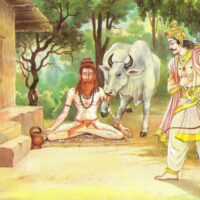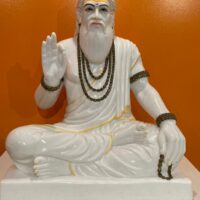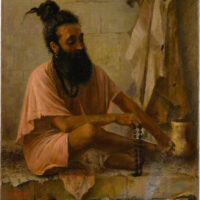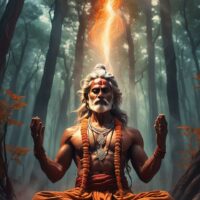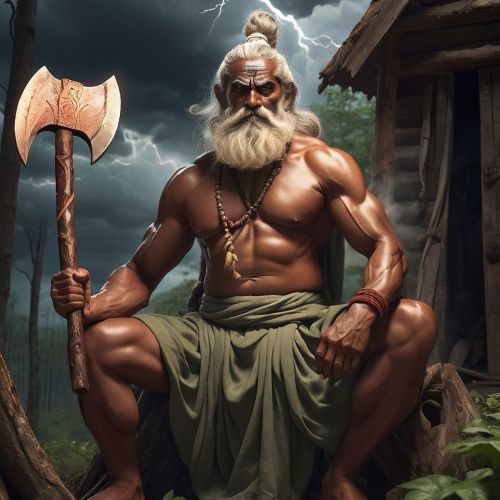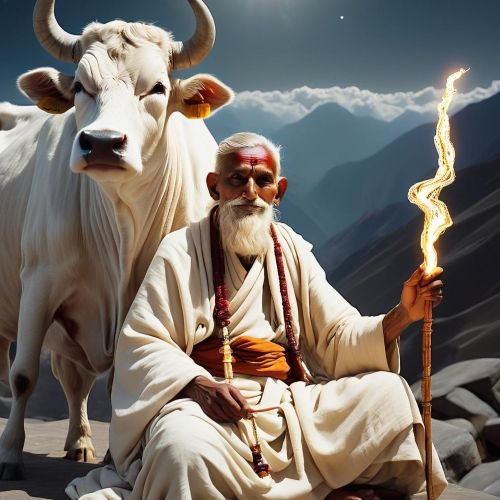Vishvamitra : The Immortal Warrior Sage
Listen
At a glance
| Description | |
|---|---|
| Origin | Indian Mythology |
| Classification | Mortals |
| Family Members | King Gadhi (Father), Satyavati (Mother), Madhuchhanda, Ashtaka, Shunahshepa, Sushruta, Shakuntala (Children) |
| Region | Indian |
| Associated With | Warfare, Immortality, Teaching |
Vishvamitra
Introduction
Vishvamitra, one of the most venerated sages in Hindu mythology, represents a powerful narrative of personal evolution and divine aspiration. Born as a mighty king named Kaushika, he underwent a dramatic transformation to become a Brahmarishi—a title reserved for the most spiritually accomplished seers. His journey is marked by fierce determination, inner conflict, and eventual enlightenment, making him a symbol of what can be achieved through sheer will and devotion. His presence in ancient epics like the Ramayana and his association with the sacred Gayatri Mantra have made his legacy timeless, extending far beyond myth into modern Indian consciousness. Vishvamitra’s story illustrates the eternal conflict between ego and humility, power and wisdom, making his life a profound philosophical blueprint for seekers of truth.
Physical Traits
Although ancient texts seldom provide detailed physical descriptions of sages, Vishvamitra’s evolution from warrior to ascetic has been portrayed in ways that reflect both his royal origin and spiritual stature. In his early years as a Kshatriya, his bearing was that of a powerful ruler—muscular, upright, and charismatic. Even after renouncing his throne, his presence remained imposing. Artists and poets describe him with long matted hair and intense eyes that radiated the fire of his tapasya, or spiritual austerities.
His physical form is often said to be imbued with symbolic elements beyond normal human traits. Esoteric traditions ascribe to him extraordinary features—chakras connecting him to unmanifested realms, radiant energies coursing through his form, and subtle divine mechanisms within his body designed to maintain cosmic balance. According to mystical interpretations, Vishvamitra had the ability to split into thousands of forms simultaneously and carried within himself a spiritual galaxy referred to as the Royal Field. These descriptions serve not as literal anatomical details but as metaphors for the vast spiritual energy and capacity he embodied.
Family
Vishvamitra was born into the royal lineage of the Amavasu dynasty. His father, King Gadhi, traced his ancestry to King Kushanabha, tying Vishvamitra to an illustrious Kshatriya bloodline. His birth name, Kaushika, reflected this noble heritage. Despite his initial role as a worldly king, Vishvamitra’s destiny was shaped by interactions with sages and divine beings that would catalyze his transformation.
His romantic association with the celestial nymph Menaka, sent by Indra to disrupt his meditations, resulted in the birth of Shakuntala—a figure immortalized in Kalidasa’s famed play. Shakuntala later married King Dushyanta, and their son Bharata became the eponymous ancestor of India (Bharat). Through this lineage, Vishvamitra is intricately woven into the genealogical and mythological fabric of India’s identity. He also mentored Rama and Lakshmana in their youth, thus linking his spiritual guidance to one of the most revered avatars of Vishnu.
Other names
Over the course of his life, Vishvamitra acquired several epithets that reflected his evolving identity and expanding spiritual influence. Born Kaushika, he was initially referred to by names associated with his lineage. The title “Vishvamitra,” meaning “friend of the universe,” emerged after he undertook intense penance, renouncing his kingdom in pursuit of spiritual wisdom. This name symbolized his transcendence of narrow personal identity in favor of universal love and service.
He has also been called Rajarshi—a sage with royal roots—and eventually Brahmarishi, the rarest spiritual title, bestowed upon him only after gaining full recognition from his rival and peer, the sage Vasishta. In spiritual lore, he has been given names like Apoorva Neela Vajram, acknowledging the immense energies he received from Mula Brahman, the ultimate divine source. Variations of his name appear across languages and regions, underscoring his pan-Indian and even trans-cultural significance.
Powers and Abilities
Vishvamitra’s spiritual strength was not inherited—it was earned through immense effort, struggle, and self-purification. One of the most famous demonstrations of his power is the creation of Trishanku Swarga, a parallel heaven constructed for King Trishanku, whom the gods refused to admit in his mortal form. When Indra disrupted Trishanku’s ascent, Vishvamitra countered by creating an alternate cosmic realm, a feat that shocked even the gods.
His mastery over mantras and weapons placed him among the most powerful sages in history. He was entrusted with the teaching of advanced astras (divine weapons) to Rama and Lakshmana, preparing them for their future battles. He also accessed realms and dimensions unknown even to most gods, consulting with the Supreme Intelligence on matters of creation and cosmic order. His knowledge extended to the control and transformation of unmanifested energies, shaping his abilities in creation, destruction, and healing.
Accounts suggest that Vishvamitra developed unique types of energy, including colorless and transparent forces derived from his cosmic travels. His multitasking capacity was unparalleled—he could simultaneously manifest in multiple dimensions while continuing his work on Earth. These extraordinary capabilities demonstrate a being who had transcended normal limitations, mastering both inner and outer worlds.
Modern Day Influence
In contemporary times, Vishvamitra’s influence remains deeply embedded in Hindu culture and beyond. His authorship of the Gayatri Mantra—one of the most sacred and widely recited Vedic hymns—cements his legacy as a spiritual guide whose teachings continue to shape daily rituals and philosophical outlooks. Millions of people chant the Gayatri Mantra as a prayer for enlightenment and wisdom, honoring the sage who first received it.
In modern literature, Vishvamitra’s story is revisited in various formats, from classical texts to graphic novels and mytho-fiction. Authors like Dr. Vineet Aggarwal have reinterpreted his life in the light of contemporary spiritual struggles, drawing parallels between ancient discipline and modern self-mastery. Publishers such as Amar Chitra Katha have introduced his story to new generations through illustrated storytelling, making his complex journey accessible to young readers.
His transformation from a prideful king to a humble sage continues to resonate as an allegory for personal growth. In a world grappling with material excess and spiritual deficiency, Vishvamitra’s tale offers a timeless reminder of what can be achieved through discipline, inner work, and the pursuit of higher truth. He also remains a symbol in academic and religious discussions about the power of human will over destiny, the struggle between ego and enlightenment, and the relationship between human effort and divine grace.
Related Images
Source
Glorious Hinduism. (2017, October 13). Vishwamitra. Retrieved from https://glorioushinduism.com/2017/10/13/vishwamitra/
Hindu Online. (n.d.). Vishvamitra. Retrieved from https://hinduonline.co/HinduReligion/Saints/Vishvamitra.html
Hindu Temple Talk. (2023, August 28). Vishvamitra: A Sage of Transformation. Retrieved from https://hindutempletalk.org/2023/08/28/vishvamitra-a-sage-of-transformation/
Histoires du Monde. (n.d.). Tales of Vishwamitra, the wise king. Retrieved from https://histoires-du-monde.com/en/indian-mythology/the-tales-of-vishwamitra-the-sage-king/
Jatland Wiki. (2020, July 2). Vishwamitra. Retrieved from https://www.jatland.com/home/Vishwamitra
Medium. (2023, September 27). Vishwamitra: The Sage of Transformation. Retrieved from https://medium.com/@shresthanr7308/vishwamitra-the-sage-of-transformation-3c0e797beab9
The Spiritual Scientist. (2025, January 7). The story of Vishwamitra – part 2 – Overcoming anger and arrogance. Retrieved from https://www.thespiritualscientist.com/the-story-of-vishwamitra-part-2-overcoming-anger-and-arrogance-2/
The Hindu. (2017, June 22). Analysing the episode of apsara Menaka and sage Vishwamitra. Retrieved from https://www.thehindu.com/society/history-and-culture/analysing-the-episode-of-apsara-menaka-and-sage-vishwamitra/article19125560.ece
Vedicfeed. (2024, October 25). Vishwamitra – The King Who Became a Great Sage. Retrieved from https://apam-napat.com/entities-vishwamitra/
Vedicfeed. (n.d.). Rishi Vishwamitra – The King Who Became a Great Sage. Retrieved from https://vedicfeed.com/brahmarishi-vishwamitra/
Vedic Math School. (2020, June 13). Rishi Vishvamitra – The Great Sage. Retrieved from https://vedicmathschool.org/rishi-vishwamitra-the-great-sage/
VishwaAmara. (2010, December 25). Vishwamitra Maharshi – The Brightest Light. Retrieved from https://www.vishwaamara.com/rishis-and-work/vishwamitra-maharshi-the-brightest-light/
Wisdomlib. (n.d.). Vishvamitra: Significance and symbolism. Retrieved from https://www.wisdomlib.org/concept/vishvamitra
Wisdomlib. (2019, January 28). Story of Viśvāmitra. Retrieved from https://www.wisdomlib.org/hinduism/compilation/puranic-encyclopaedia/d/doc242072.html
Wisdomlib. (2020, September 28). Chapter 34 – Gadhi is the father of Vishvamitra. Retrieved from https://www.wisdomlib.org/hinduism/book/the-ramayana-of-valmiki/d/doc423884.html
Wisdomlib. (2024, October 30). Rishi Vishvamitra: Significance and symbolism. Retrieved from https://www.wisdomlib.org/concept/rishi-vishvamitra
Yogapedia. (n.d.). Who is Brahmarishi Vishwamitra? – Definition from Yogapedia. Retrieved from https://www.yogapedia.com/definition/10348/brahmarishi-vishwamitra
Frequently Asked Questions
What is lorem Ipsum?
I am text block. Click edit button to change this text. Lorem ipsum dolor sit amet, consectetur adipiscing elit. Ut elit tellus, luctus nec ullamcorper mattis, pulvinar dapibus leo.
What is lorem Ipsum?
I am text block. Click edit button to change this text. Lorem ipsum dolor sit amet, consectetur adipiscing elit. Ut elit tellus, luctus nec ullamcorper mattis, pulvinar dapibus leo.
What is lorem Ipsum?
I am text block. Click edit button to change this text. Lorem ipsum dolor sit amet, consectetur adipiscing elit. Ut elit tellus, luctus nec ullamcorper mattis, pulvinar dapibus leo.
What is lorem Ipsum?
I am text block. Click edit button to change this text. Lorem ipsum dolor sit amet, consectetur adipiscing elit. Ut elit tellus, luctus nec ullamcorper mattis, pulvinar dapibus leo.
What is lorem Ipsum?
I am text block. Click edit button to change this text. Lorem ipsum dolor sit amet, consectetur adipiscing elit. Ut elit tellus, luctus nec ullamcorper mattis, pulvinar dapibus leo.


